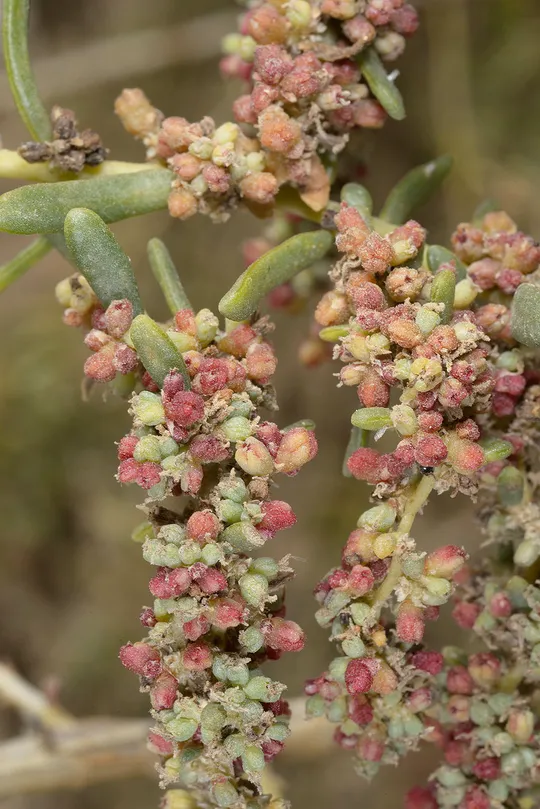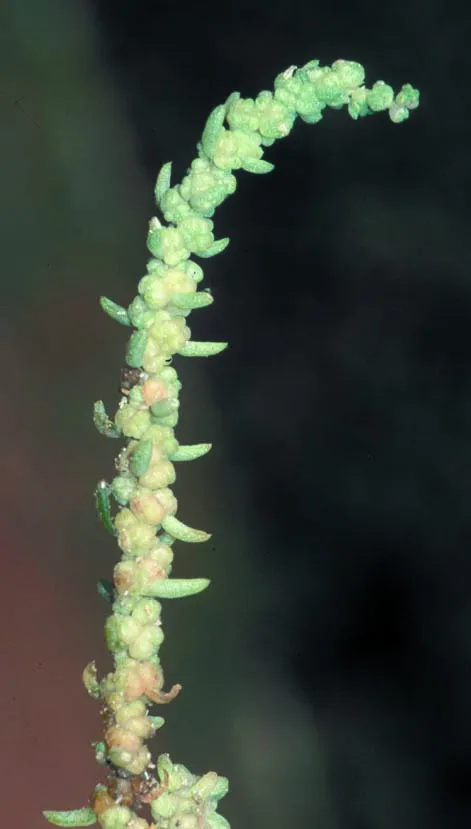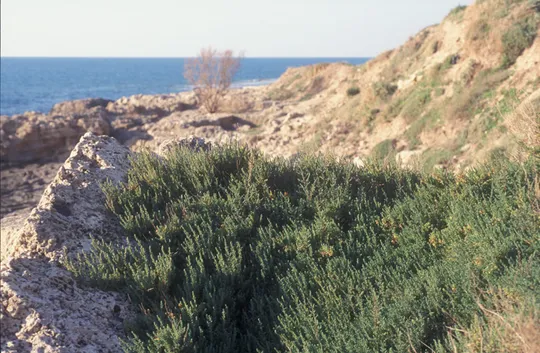Suaeda vermiculata

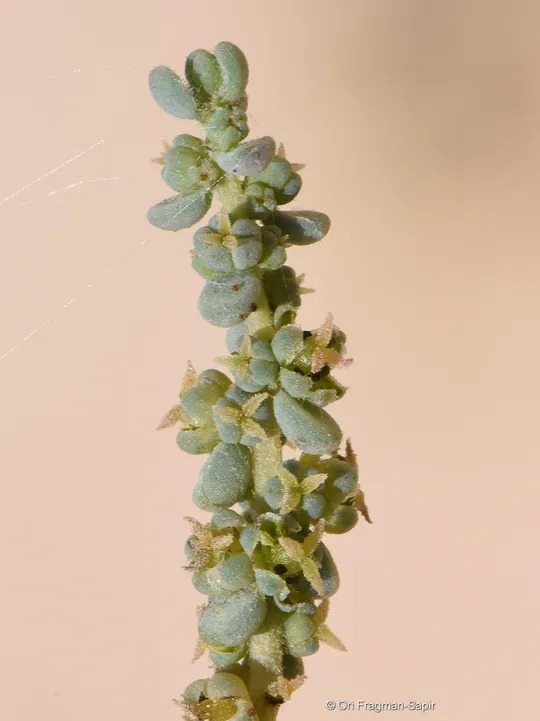
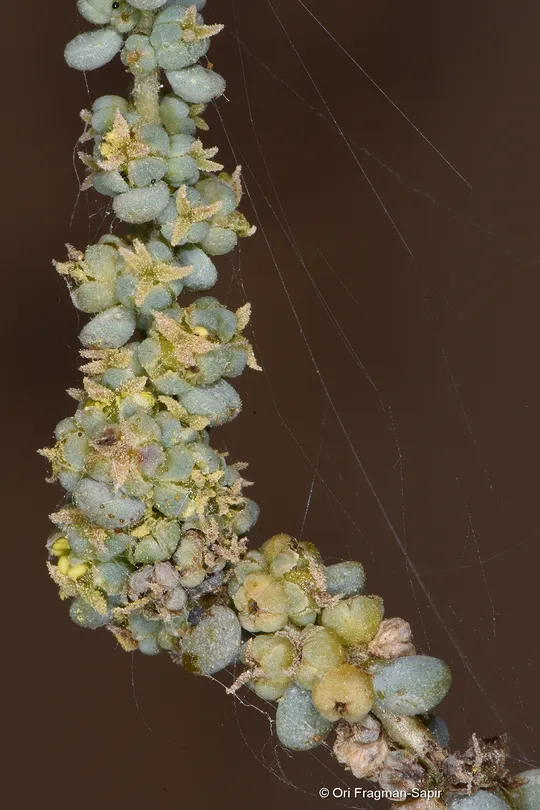
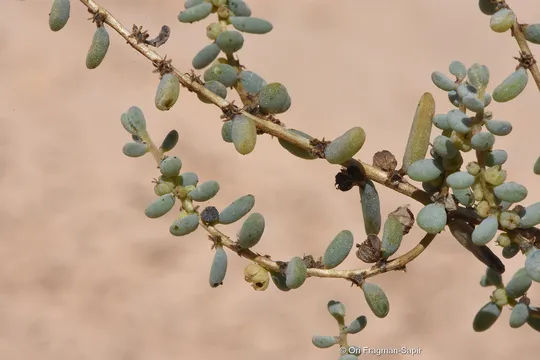
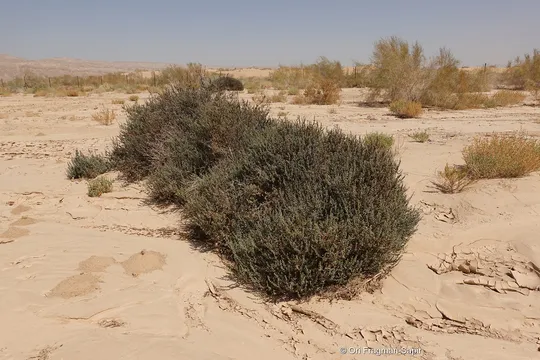
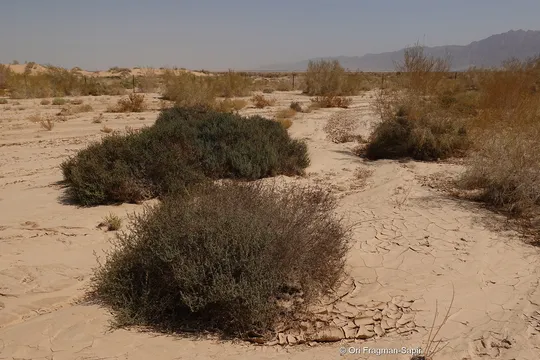
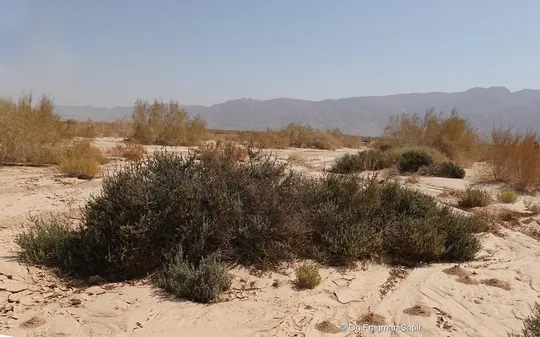
Suaeda vermiculata is a spherical, densely branched, occasionally cushion-like dwarf shrub, 17-32 cm tall. It has cylindrical, succulent, bluish leaves. The plant is hairless and does not excrete salt. Its young parts are ciliated and branches from previous years are woody and rigid. The upper leaves are lens-like, short and plump, occasionally spherical; lower leaves are more cylindrical. Some of the leaves have a flat cross-section. Under stress conditions, the leaves become purple-reddish. The leaf has a short (1-2 mm) but distinct petiole. The tiny green flowers (3 mm), all hermaphrodite, are arranged along the new branches of the seasonal growth, singly or in groups of 1-3. Each flower has five green perianth lobes. The fruit is a nutlet containing one wingless seed. S. vermiculata flowers mainly from March to April. Some plants flower sparsely in summer as well, particularly individuals growing in disturbed sites.
Grows mainly in the southern Arava. There is a single observation from Wadi Kasuy in southern Negev, which could be plants that “strayed” from the Arava. Its current distribution is in the Arava salt marshes, in areas under development. It is apparently extinct from the Eilat salt marsh. The only location in which it survived with certainty is in the southern Arava salt marshes (Yotvata and Evrona). Zohary (1980) mentions it from the Dead Sea region at the mouth of Wadi Zohar and in the Sdom salt marsh, where it is not found today. It is recorded in the literature from the “Jordan Plains” and the lower Jordan Valley but its current status there is not clear, and is associated with the confusion with Suaeda palaestina. In the Jerusalem Herbarium, there is a single specimen from the Ǧiftlik area from 1970, which was identified as Suaeda vermiculata, but is almost certainly a mistake. In the Wadi Malaha Reserve in the Jordan Valley, there are three related Suaeda species (S. vermiculata, S. palaestina and S. vera). A taxonomic-population study should be made on their status. S. vermiculata most probably does not grow in the valley
Grows in extreme desert salt marshes ("Ka") in whose center there is saline clay soil, as well as in humid salt marshes in warm deserts.
For the genus Suaeda see Suaeda palaestina. S. vermiculata and S. palaestina are similar to one another as well as to Suaeda asphaltica that grows in the Judean Desert, although they are shorter and much smaller than it, usually with thicker, shorter leaves. Another species growing in salt marshes is Suaeda fruticosa, which differs from S. vermiculata differs in its sparser growth pattern.
• Development trends in the southern Arava and the plans to establish an airport threatened to destroy salt marsh areas and to lead to the extinction of surviving Suaeda vermiculata populations. These plans were cancelled and the airport will be built in the area opposite Be’er Ora.
• The plants in each population grow several meters apart. The populations are fragmented according to the fragmentation pattern of humid salt marshes in warm desert areas.
• The species is rare in Israel, but is apparently not endangered in most of the countries in its range, where there is less development pressure.
• Protected in the Evrona and Yotvata nature reserves; most of the Evrona salt marsh is in the process of being declared a nature reserve. The Yotvata salt marsh is also protected within the Yotvata Nature Reserve,
The Evrona Reserve population should be monitored. In the Yotvata Reserve, grazing pressure should be regulated and groundwater levels in the areas in which Suaeda grows and is being rehabilitated should be controlled.
A Saharo-Arabian plant of warm deserts. Grows in Iraq, Jordan (eastern Amon, the Arava and Ghor), Arabia, Sinai and Egypt.
A dwarf shrub growing in desert salt marshes in the southern Arava and in the Jordan Valley. Part of its habitat was destroyed by development. The species has Red status due to its rarity and the vulnerability of its habitat and populations. The population in the southern Evrona salt marsh, which borders on the flamingo salt pools, should be rehabilitated.
Current Occupancy Map
| 1000 squre meter pixel | 5000 squre meter pixel | 10000 squre meter pixel | |
|---|---|---|---|
| number of observations | 0 | 0 | 0 |
| in total pixels | 0 | 0 | 0 |
| Family | Chenopodiaceae |
| Classification | On the endangered species list |
| Ecosystem | Desert |
| Chorotype | Saharo-Arabian |
| Conservation Site | Evrona salt marsh |
| Rarity |
1
4
6
|
|---|---|
| Vulnerability |
0
3
4
|
| Attractiveness |
0
0
4
|
| Endemism |
0
0
4
|
| Red number |
1
3.7
10
|
| Peripherality | 0 |
| IUCN category | DD EW EX LC CR EN VU NT |
| Threat Definition according to the red book | Vulnerable |
 Based on:
Based on:
